#low Earth orbit (LEO)
Explore tagged Tumblr posts
Text

I’m my Cardi B voice: What was the reason?


How will the bolt-ons hold up in space?
It costs $68 million per launch. 😡
I have questions and concerns.😂
#jeff bezos#blue origin#rocket#new glenn#gayle king#lauren sanchez#Katy Perry#amanda nguyen#aisha bowe#kerianne flynn#billionaire#toys#rocket launch#low earth orbit#Leo#commercial missions#space#John Glenn#astronaut#wasteful spending#womankind
17 notes
·
View notes
Text
Spacex.... BIG GOALS!!!
youtube
🚀 🔥🍌
#gwynne shotwell#spacex#elon musk#musk#starship#interplanetary travel#leo#low earth orbit#banana for scale#🍌#tony stark#the emperor has no clothes#hyperloop#the boring company#co2 emissions#climate change#climate crisis#osint#tsla#corporations#ceo#elongated muskrat#elon muskrat#the muskrat#apartheid clyde#las vagas#boca chica#thunderf00t#youtube
3 notes
·
View notes
Text
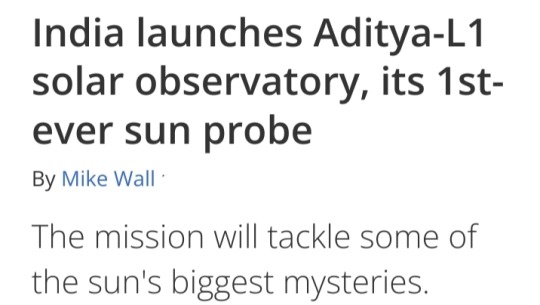
2 September 2022
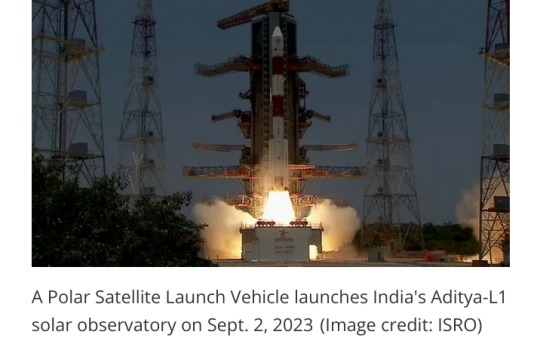
Fresh off its success at the moon, India is now headed for the sun.
The nation launched its first-ever solar observatory today (Sept. 2), sending the Aditya-L1 probe skyward atop a Polar Satellite Launch Vehicle (PSLV) from Satish Dhawan Space Centre at 2:20 a.m. EDT (0620 GMT; 11:50 a.m. local India time).
The PSLV deployed Aditya-L1 into low Earth orbit (LEO) as planned about 63 minutes after liftoff, sparking applause and high fives in mission control.
"Congratulations, India, and congratulations, ISRO [the Indian Space Research Organisation]," Jitendra Singh, India's Minister of State for Science and Technology, said shortly after deployment on ISRO's launch webcast.
"While the whole world watched this with bated breath, it is indeed a sunshine moment for India," Singh added.
The successful launch followed on the heels of another big milestone for India: On August 23, its Chandrayaan-3 mission became the first to land softly near the moon's south pole.
Chandrayaan-3's lander-rover duo are expected to conk out in a week or so, when the harsh lunar night falls at their touchdown site. But Aditya-L1's long journey has just begun.
A long road to a good sun-viewing spot
Aditya-L1 won't stay in LEO forever:
After a series of checkouts, it will use its onboard propulsion system to head toward Earth-sun Lagrange Point 1 (L1), a gravitationally stable spot about 1 million miles (1.5 million kilometers) from our planet in the direction of the sun.
That destination explains the latter part of the mission's name. And the first part is simple enough: "Aditya" translates to "sun" in Sanskrit.
The 3,260-pound (1,480 kilograms) observatory will arrive at L1 about four months from now, if all goes according to plan.
But the long trek will be worth it, according to the ISRO.
"A satellite placed in the halo orbit around the L1 point has the major advantage of continuously viewing the sun without any occultation/eclipses," ISRO officials wrote in an Aditya-L1 mission description.
"This will provide a greater advantage of observing the solar activities and its effect on space weather in real time."
Indeed, another sun-studying spacecraft is already at L1 — the Solar and Heliospheric Observatory (SOHO), a joint NASA-European Space Agency mission that launched in December 1995.
(Several other spacecraft, including NASA's James Webb Space Telescope, are at Earth-sun Lagrange Point 2, which is a million miles from Earth, in the direction away from the sun.)

Solar flares, the coronal heating mystery and more
Once it's settled in at L1, the solar probe will use four three science instruments to study the particles and magnetic fields in its immediate surroundings and four others to scrutinize the sun's surface (known as the photosphere) and its atmosphere.
This work will help scientists better understand solar activity, including the dynamics of solar flares and coronal mass ejections (CMEs), ISRO officials say.
Flares are powerful flashes of high-energy radiation, and CMEs are huge eruptions of solar plasma.
Both types of outburst can affect us here on Earth. Intense CMEs that hit our planet, for example, trigger geomagnetic storms that can disrupt satellite navigation and power grids.
(As a side benefit, such storms also supercharge the gorgeous light shows known as auroras.)
Aditya-L1 will also tackle the "coronal heating problem," one of the biggest mysteries in heliophysics.
The corona — the sun's wispy outer atmosphere — is incredibly hot, reaching temperatures around 2 million degrees Fahrenheit (1.1 million degrees Celsius), according to NASA.
That's about 200 times hotter than the solar surface, which is "only" 10,000 degrees F (5,500 degrees C) or so.
It's still unclear what is responsible for this startling and counterintuitive discrepancy.
(Why would it be hotter away from the sun's core, where the energy-producing nuclear fusion reactions are occurring?)
Aditya-L1 has other science goals as well. For instance, the mission also aims to more fully flesh out the solar wind, the stream of charged particles flowing constantly from the sun, ISRO officials said.
Aditya-L1 will measure the composition of the solar wind and attempt to determine how it is accelerated.
And Aditya-L1 will do all this work on the cheap:
The mission's price tag is about 3.8 billion rupees, or $46 million US at current exchange rates.
That's in the same ballpark as Chandrayaan-3
India's first successful moon-landing mission costs about 6.15 billion rupees, or $74 million US.
For comparison, NASA's most recent big-ticket sun mission, the record-setting Parker Solar Probe, costs roughly $1.5 billion.
This disparity should not be viewed as an indictment of NASA, however; labor costs are much higher in the United States than in India, among other differences between the two nations' economies.
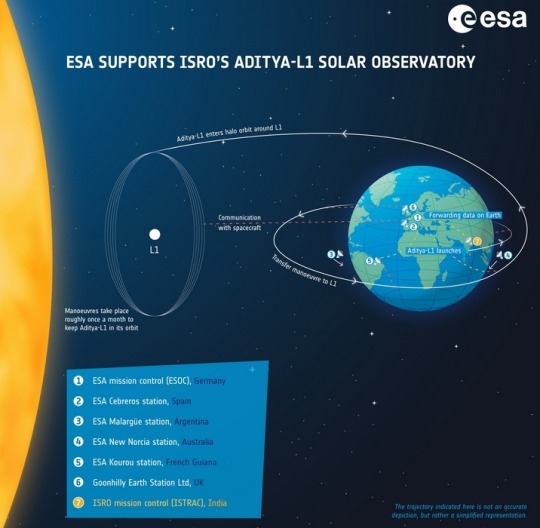
Aditya-L1 is a coronagraphy spacecraft to study the solar atmosphere, designed and developed by the Indian Space Research Organisation (ISRO) and various other Indian research institutes.
#India#Aditya-L1#Polar Satellite Launch Vehicle (PSLV)#Satish Dhawan Space Centre#low Earth orbit (LEO)#sun#Indian Space Research Organisation#Chandrayaan-3#Earth-sun Lagrange Point 1 (L1)#Solar and Heliospheric Observatory (SOHO)#solar flares#coronal mass ejections (CMEs)#coronal heating problem#heliophysics#solar wind#Parker Solar Probe#NASA#solar observatory#solar atmosphere
13 notes
·
View notes
Text
The Low Earth Orbit (LEO) satellite market is experiencing an unprecedented boom. Projected to grow from USD 11.81 billion in 2025 to USD 20.69 billion by 2030, the market is advancing at a CAGR of 11.9%.
0 notes
Text
Gateway to Deep Space: Future of Indian Human Spaceflight
ISRO’s SpaDeX mission, with its success in autonomous docking and orbital operations, lays the technological cornerstone for India’s human spaceflight future—from Gaganyaan and space station assembly to lunar sample return and interplanetary missions. The Indian Space Research Organisation’s SpaDeX mission is far more than a technological milestone—it is a harbinger of India’s readiness to step…
#Bharatiya Antariksha Station (BAS)#featured#Indian Human Spaceflight#low Earth orbit (LEO)#sciencenews#SPADEX
0 notes
Text
Lost in the Woods? Your Cell Tower Just Orbited Over You
"No Service" in the middle of nowhere? Discover how the lack of connectivity can be a significant challenge, especially during unexpected situations. #Innovation #Connectivity #Starlink #DirectToCell #ElonMusk #BroadbandNetworker #FundTheInternet
I vividly remember a time during a solo farm trip along the Ogun-Osun River Basins. I was attempting to navigate a tricky section of the road, the weather was turning, and I desperately needed to check the forecast. Unfortunately, my phone displayed the dreaded “No Service” message. Panic began to set in. This experience highlighted the limitations of traditional networks and the urgent need for…
#Cell towers#Connectivity#Direct-to-cell technology#low-Earth orbit (LEO) satellites#Lynk Global#SpaceX’s Starlink
0 notes
Text
LEO Satellites - How do they stay in orbit ?
On a clear evening what appears as a slowly moving trail of light could be starlink satellites. You might wonder who turned the lights on in them ?
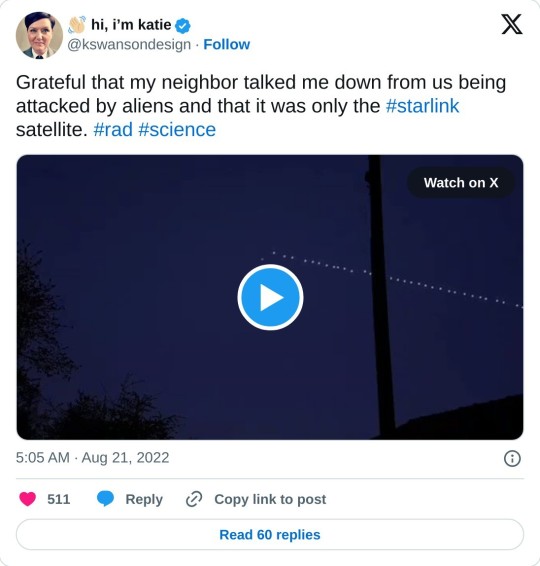
These are starlink satellites that are placed in the Low Earth Orbit - around 200-800 Km from the earth's surface. This is very close to earth for an orbiting satellite. In fact the gravity experienced by these satellites would be almost the same as the gravity experienced at earth's surface.
To understand how they manage to be in orbit, let us to do a thought experiment. Say you throw a stone across a pond. the higher the force that you impart on it, the longer the distance it travels. Now imagine that you manage to impart a force so strong, that it travels the entire earth and comes around to hit you on the head. Well, that is what is happening with these satellites at around 200km above the earth's surface.

There are two major forces that are acting on such a rock that is orbiting around the earth - the gravity and the centrifugal force. While the gravity tries to pull the rock towards the earth the centrifugal force acts on the opposite direction counteracting it.
To understand centrifugal force, let us go back to the childhood play thing of the spinning disk and a post or a devil's wheel of Oktober fest.
youtube
The centrifugal force is the force that is pushing you outward from the spinning disk. The farther from the center, the bigger the force. The centrifugal force can also be increased by increasing the velocity. Thus, for an object to be at orbit without falling, it has to be as far as possible from the earth's surface, and/or have a higher velocity while revolving around the earth.
For an object to be in LEO, it must be travelling at around 7.8 km/s depending on the altitude. And these satellites revolve around the earth around 12-16 times a day, depending on the altitude.
Unlike geo-synchronous (GEO) satellites that are at an altitude of 36000 Kms and are stationary with respect to earth, these satellites move with respect to earth. Hence they need lots of satellites to cover the entire earth and they could need base stations to hand over signals. They also suffer from doppler, which must be corrected as well.
Though the air is less dense at 200km, LEO satellites still face significant air resistance, and they lose their altitude. To correct this they use rockets to boost their altitude three to four times a year. They are powered by solar energy with battery backup.
The International Space Station is also at a Low Earth Orbit, enabling faster and cheaper travel between the space station and the earth. Since the centripetal force and the gravity are equalized, the astronauts at the space station feel weightlessness or zero gravity.

The Starlink satellites reflect the sun, and hence they appear to shine, sparkle and shimmer!
0 notes
Text
The Benefits of Semiconductor Manufacturing in Low Earth Orbit (LEO) for Terrestrial Use
Subject Matter Experts (SMEs) in semiconductor and in-space manufacturing collaborated on a white paper that outlines how microgravity benefits the production of semiconductors and related materials. Earth’s gravitational forces pose substantial barriers to quick, high-yield semiconductor production. Microgravity offers a path to overcome these barriers. There are also substantial practical benefits to incorporating LEO-based manufacturing […] from NASA https://ift.tt/1iTuDrL
#NASA#space#The Benefits of Semiconductor Manufacturing in Low Earth Orbit (LEO) for Terrestrial Use#Michael Gabrill
0 notes
Text
Connecting the World: Telecommunications Satellites Enhance Global Communication Networks

In an increasingly interconnected world, the role of telecommunications has never been more critical. The rapid growth of digital communication technologies has significantly transformed the way we live, work, and interact with one another. At the heart of this transformation lies a technology that orbits high above us – telecommunications satellites. These sophisticated machines play a pivotal role in bridging gaps across continents, bringing people closer, and enabling the seamless exchange of information on a global scale.
Telecommunications satellites are the backbone of modern communication networks. These satellites are designed to transmit signals across vast distances, overcoming the limitations of terrestrial infrastructure. By relaying signals from one point on the Earth's surface to another, they enable instant communication, regardless of geographical barriers. This capability has revolutionized various sectors, from media broadcasting to internet services, emergency communications, and more.
The Evolution of Telecommunications Satellites
The journey of telecommunications satellites began in the mid-20th century. Early experiments with satellite communication laid the groundwork for what would become a global network. The launch of the first artificial satellite, Sputnik, in 1957 marked the dawn of the space age. However, it wasn't until the launch of the first geostationary satellite in 1965 that the true potential of satellite communication was realized. This satellite, positioned in a fixed location relative to the Earth's surface, could provide continuous coverage to a specific region, paving the way for real-time communication across the globe.
Since then, telecommunications satellites have evolved dramatically. Advances in technology have led to the development of more sophisticated satellites with greater capacity, reliability, and efficiency. Modern satellites are equipped with high-powered transponders, enabling them to handle large volumes of data transmission. These advancements have expanded the capabilities of satellite communication, making it an indispensable part of the global communication network.
How Telecommunications Satellites Work
The operation of telecommunications satellites is based on the principles of radio frequency transmission. These satellites receive signals from ground-based stations, amplify them, and retransmit them back to other ground stations. The process involves several key components:
Uplink: The transmission of signals from a ground station to the satellite. This is typically done using high-frequency radio waves.
Transponder: The component within the satellite that receives the uplink signal, amplifies it, and changes its frequency for retransmission.
Downlink: The transmission of signals from the satellite back to a ground station. This completes the communication loop, allowing the original signal to reach its intended destination.
Satellites are positioned in different orbits depending on their specific functions. Geostationary satellites, which orbit at approximately 35,786 kilometers above the equator, provide continuous coverage to specific regions. Low Earth orbit (LEO) satellites, positioned much closer to the Earth's surface, offer lower latency and are often used for services requiring real-time data transmission, such as internet connectivity.
Impact on Global Communication Networks
The impact of telecommunications satellites on global communication networks is profound. They have enabled a level of connectivity that was previously unimaginable, facilitating the seamless exchange of information across vast distances. Here are some key areas where their impact is most evident:
Media and Broadcasting
Telecommunications satellites have revolutionized the media and broadcasting industry. They enable the transmission of television and radio signals to remote and underserved areas, ensuring that people worldwide have access to information and entertainment. Live broadcasts of major events, such as sports competitions and political speeches, are made possible through satellite technology, allowing audiences to experience these moments in real time.
Internet Connectivity
In many parts of the world, terrestrial internet infrastructure is either insufficient or nonexistent. Telecommunications satellites provide a vital solution to this problem by offering internet connectivity to remote and rural areas. Satellite internet services have become increasingly popular, providing reliable and high-speed internet access to communities that were previously disconnected.
Emergency Communications
During natural disasters and emergencies, terrestrial communication networks are often disrupted. Telecommunications satellites play a crucial role in providing emergency communication services, ensuring that rescue and relief operations can be coordinated effectively. Satellite phones and portable satellite communication devices are essential tools for first responders and humanitarian organizations, enabling them to maintain communication in even the most challenging conditions.
Global Navigation Systems
Telecommunications satellites are also integral to global navigation systems. They provide the precise timing and positioning data required for navigation and location-based services. These systems are essential for various applications, including aviation, maritime, and land transportation, as well as for personal navigation devices used by millions of people worldwide.
Future Trends and Developments
The field of telecommunications satellites is continually evolving, driven by advancements in technology and increasing demand for connectivity. Several trends and developments are shaping the future of this industry:
High Throughput Satellites (HTS)
High throughput satellites represent a significant advancement in satellite technology. These satellites offer substantially increased data transmission capacity, enabling faster and more reliable communication services. HTS technology is particularly beneficial for providing broadband internet access to remote and underserved areas, helping to bridge the digital divide.
Constellations of LEO Satellites
One of the most exciting developments in satellite communication is the deployment of constellations of low Earth orbit satellites. These constellations consist of hundreds or even thousands of small satellites working together to provide global coverage. LEO constellations offer lower latency and higher data transfer rates compared to traditional geostationary satellites, making them ideal for applications such as internet of things (IoT) connectivity and real-time data services.
Advances in Satellite Manufacturing
Advances in satellite manufacturing are making it possible to produce smaller, more cost-effective satellites. These miniaturized satellites, often referred to as smallsats or cubesats, can be launched in large numbers, providing flexible and scalable communication solutions. The reduced cost of manufacturing and launching these satellites is driving innovation and enabling new players to enter the market.
Integration with Terrestrial Networks
The integration of satellite communication with terrestrial networks is another key trend. Hybrid networks that combine satellite and terrestrial technologies can offer seamless connectivity, ensuring that users have access to reliable communication services regardless of their location. This integration is particularly important for providing consistent internet coverage in areas with challenging terrain or sparse infrastructure.
Challenges and Considerations
While telecommunications satellites offer numerous benefits, there are also challenges and considerations to address. One of the primary challenges is the cost associated with launching and maintaining satellites. The development, launch, and operation of satellites require significant investment, which can be a barrier for some organizations.
Additionally, the increasing number of satellites in orbit raises concerns about space debris and collision risks. Ensuring the long-term sustainability of space activities requires careful management of satellite operations and the implementation of measures to mitigate the risk of space debris.
Conclusion
Telecommunications satellites have fundamentally transformed global communication networks, enabling instant connectivity and information exchange across vast distances. From media broadcasting and internet connectivity to emergency communications and global navigation, the impact of these satellites is far-reaching and profound.
As technology continues to advance, the future of telecommunications satellites looks promising. High throughput satellites, LEO constellations, and advancements in satellite manufacturing are set to further enhance the capabilities of satellite communication. By overcoming challenges and embracing innovation, telecommunications satellites will continue to play a crucial role in connecting the world, bridging gaps, and enabling a more connected and informed global community.
In a world where connectivity is essential, telecommunications satellites stand as a testament to human ingenuity and the relentless pursuit of progress. They embody the spirit of exploration and innovation, bringing people closer together and fostering a sense of global unity. As we look to the future, the continued evolution of telecommunications satellites promises to unlock new possibilities and drive the next wave of communication advancements.
196 notes
·
View notes
Text
I'm annoyed by this article:
Let's do an exercise: assuming an asteroid of equal mass and composition of 16 Psyche just..appeared in low Earth orbit one day (for ease of mining), what might our profit margins look like? Assuming some unrealistically optimistic numbers 'cause I'm not a rocket scientist.
The Smithsonian quotes a price for Psyche at $10 quintillion. Dividing by its mass, we get a dollar density of 44 US cents per kilogram.
Next, do a search on your engine of choice for something like "comparison of orbital launch vehicles by payload price to LEO". I'll use the "your world in data" page that comes up as my first result for my source here. We're looking for the cheapest launcher in terms of USD/kg. At time of writing, this is the Falcon Heavy.
Now we'll perform some research on exactly what the FH's payload capacity at a given price point. Being reusable and expendable complicates the math! Moreover, Falcon Heavy hasn't actually flown that many missions, so we have to do some extrapolation. Poking around the Wikipedia article and taking some unsourced claims at face value, the cheapest configuration seems to be a partially reusable configuration (core expended, boosters recovered) with a LEO payload capacity around 57,000 kg for something like $120 million USD. That's about $2100 USD/kg. (Feel free to correct me in the future if you're better at research/new data appears!)
Now we want to find the highest-performance vacuum engines available. Let's check the Wikipedia article "Comparison of orbital rocket engines" and sort by Specific Impulse, descending to get an idea of what we're working with. As of writing, we find the best chemical option available to us is the venerable RL10 at about 450-460 seconds, with the RL10C-2 leading the pack at 465.5 seconds!
Lets go back to our Falcon Heavy payload capacity. As a ballpark figure, let's assume our spacecraft has a dry mass of ten tons. Very optimistic, IMO. With our RL10C-2's fuel to oxidizer ratio of 1:5.88 (all from the L3Harris datasheet), we can cram something like 40 tons of O2 and 7 tons of H2 onto this launch vehicle. A brief bit of back-of-the-napkin math and a consultation of the Falcon User's Guide seems to indicate this'll fit in the payload fairing. The extended one, at least.
Finally: how much of Psyche can our monster RL10 upper stage haul back? Consulting the Space Shuttle Operations Manual for a deorbit burn ballpark, we find on page 33 that it's "anywhere from 200 to 550 fps". We'll be optimistic and take 200 fps. That's about 60 m/s. Solving the rocket equation for 60 m/s = 465.5 s * 9.8 m/s/s * ln((57,000kg+x)/(10,000kg+x)), we get x=~3.5 million kg. At $0.44 per kilogram, that's about $1.5 million USD. Remember how our launch vehicle cost ~120 million? We teleported Psyche to LEO and we're still in the hole $198 million. We didn't even account for the price of our upper stage!
If our launch costs are actually something closer to $240 million, what would the dollar density have to be to break even? 240/3.5 = $68/kilogram. Taking a peek at the Wikipedia "Prices of chemical elements" we find that's equivalent to an asteroid of pure Tellurium. What about ~$360 million? Pure Uranium. Still just in LEO, mind you, and we haven't even accounted for how we're gonna crash the market when we flood it with our space metal.
You aren't making a profit asteroid mining for a couple hundred years, minimum. We are not on the cusp of a plurality of humans working off-world. Same it as it ever was.
#my thoughts#spaceflight#please correct me if i made a math mistake im very tired rn#but i think this checks out#thanks ti-92p
20 notes
·
View notes
Text
The Kennedy Space Center-based research, test, and now space launch company Starfighters International, which has been flying F-104 Starfighters privately for decades is now, is in the process of acquiring a dozen F-4 Phantoms. The deal would see the iconic third-generation Cold War fighters fly primarily in service of the firm’s space launch operations, which aim to provide rapid and flexible access to low Earth orbit (LEO) for small satellites, as well as suborbital offerings. Starfighters International began as a company around three decades ago, and grew from doing air shows to becoming largely a research and development support firm with a very unique address. The company and its fleet of antique Mach 2-capable F-104 Starfighters, which includes seven airframes today, moved into Kennedy Space Center in 2007. There they would have access to arguably one of the most famous and largest runways on earth, the Shuttle Landing Facility. Now they are in the process of building a 150,000-square-foot facility in Midland, Texas, to support the firm’s more ambitious space launch aims. And this is precisely where the F-4 Phantoms come into play. While the Lockheed F-104 Starfighter is capable of zooming up into the stratosphere at high speed, they cannot carry heavier, outsized launch vehicles at the required performance that will allow larger payloads to be inserted into low Earth orbit. The F-4s — at least in concept — can.
Starfighters Space Expands to Midland, Texas Spaceport October 7, 2024 CAPE CANAVERAL, Fla., Oct. 7, 2024 /PRNewswire/ -- Starfighters Space Inc, headquartered at Kennedy Space Center, operating the world's only commercial fleet of aircraft capable of flying at sustained MACH 2+ and able to air-launch payloads at altitude, proudly announced the addition of its second launch facility at the Midland, Texas Spaceport.
Thank you to member GTX at Secret Projects Forum for bringing this to awareness.
17 notes
·
View notes
Text
The International Space Station (ISS) will be retired in 2030 after more than 32 years of continuous service. Naturally, there are questions regarding what will replace this station, which has served as a bastion for vital research and inter-agency cooperation in space. In the past, China has indicated that their Tiangong ("heavenly palace") space station will be a successor and rival to the ISS, offering astronauts from other nations an alternative platform to conduct research in Low Earth Orbit (LEO). As part of this plan, China recently announced plans to double the size of Tiangong in the coming years. This announcement was shared last Wednesday, October 4th, during the 74th International Astronautical Congress (IAC 2023) in Baku, Azerbaijan. According to the China Academy of Space Technology (CAST), three new modules will be added to Tiangong, which currently consists of the Tianhe Core Cabin Module (CMM) and two Laboratory Cabin Modules (LCM)—Wenhian ("Quest for the Heavens") and Mengtian ("Dreaming of the Heavens"). This expansion will be accompanied by extending the station's operational lifetime. According to the statement made by CAST, Tiangong will be in service for more than 15 years, 10 more years than previously announced. This means that China intends to keep Tiangong operational until 2037 or later, several years after the ISS is decommissioned and deorbited. As of the penning of this article, the station has been fully operational since late 2022 (a total of 894 days) and has been occupied for the past 764 days. The station has hosted 15 taikonauts (a maximum of three at a time) at orbital altitudes of 340 to 450 km (210 and 280 mi).
Continue Reading.
231 notes
·
View notes
Text

Hubble comes face-to-face with spiral's arms
The spiral galaxy NGC 3596 is on display in this NASA/ESA Hubble Space Telescope image that incorporates six different wavelengths of light. NGC 3596 is situated 90 million light-years from Earth in the constellation Leo, the Lion. British astronomer Sir William Herschel first documented the galaxy in 1784.
NGC 3596 appears almost perfectly face-on when viewed from Earth, showcasing the galaxy's neatly wound spiral arms. These bright arms hold concentrations of stars, gas, and dust that mark the area where star formation is most active, illustrated by the brilliant pink star-forming regions and young blue stars tracing NGC 3596's arms.
What causes these spiral arms to form? It's a surprisingly difficult question to answer, partly because spiral galaxies are so diverse. Some have clear spiral arms, while others have patchy, feathery arms. Some have prominent bars across their centers, while others have compact, circular nuclei. Some have close neighbors, while others are isolated.
Early ideas about how spiral arms formed stumped astronomers with the "winding problem." If a galaxy's spiral arms are coherent structures, its arms would wind tighter and tighter as the galaxy spins, until the arms are no longer visible.
Now, researchers believe that spiral arms represent a pattern of high-density and low-density areas rather than a physical structure. As stars, gas, and dust orbit within a galaxy's disk, they pass in and out of the spiral arms. Much like cars moving through a traffic jam, these materials slow down and bunch up as they enter a spiral arm, before emerging and continuing their journey through the galaxy.
IMAGE: This Hubble Space Telescope image showcases the spiral galaxy NGC 3596. Credit: ESA/Hubble & NASA, D. Thilker
13 notes
·
View notes
Text
The Low Earth Orbit (LEO) satellite market is entering a transformative phase. With a projected surge from USD 11.81 billion in 2025 to USD 20.69 billion by 2030, growing at a CAGR of 11.9%,.
0 notes
Text
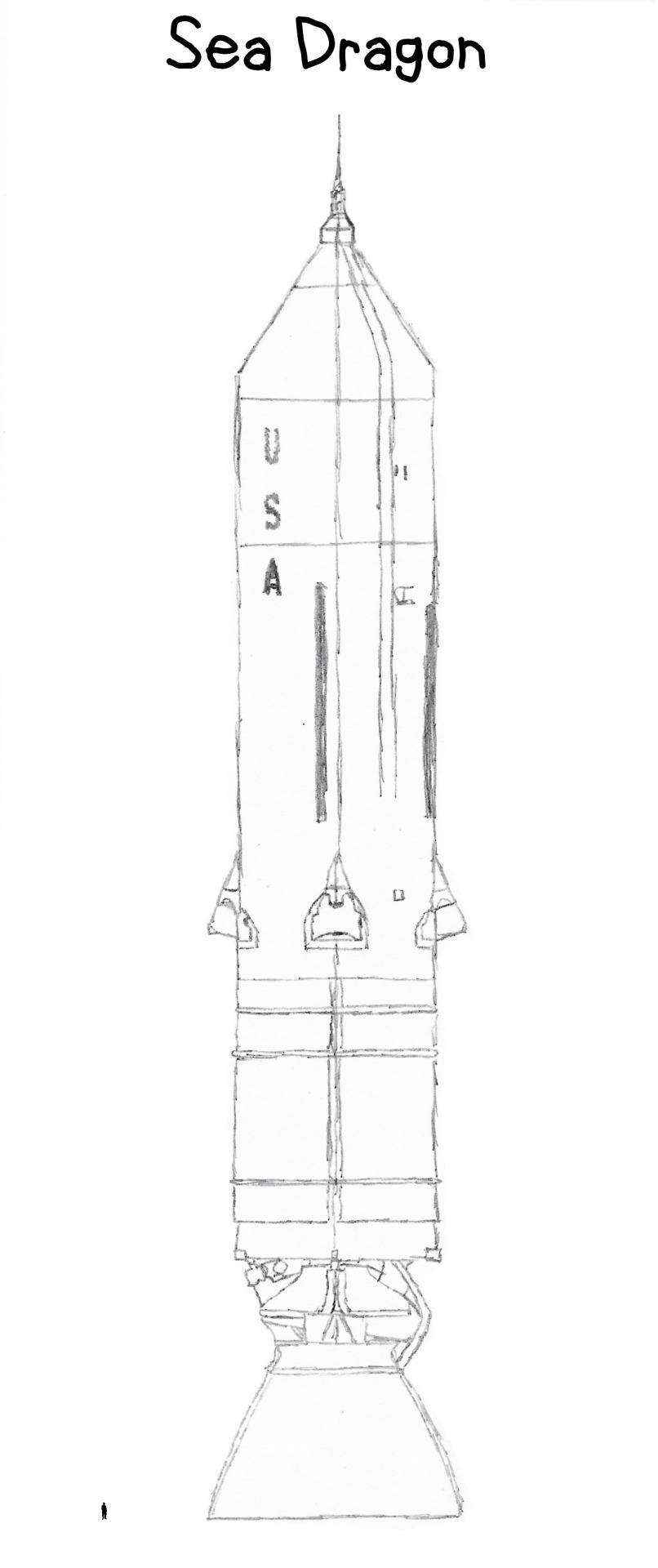
The Sea Dragon was a conceptual design for a super heavy-lift launch vehicle proposed in 1962 by Robert Truax while working at Aerojet. It was designed to be sea-launched, meaning the rocket would be floated in the ocean before liftoff, reducing infrastructure costs. With a height of 150 meters (490 feet) and a diameter of 23 meters (75 feet), it would have been the largest rocket ever built. The first stage was powered by a single massive engine producing 350 MN (79,000,000 lbf) of thrust, burning RP-1 and liquid oxygen (LOX). The second stage used liquid hydrogen (LH2) and LOX, generating 59 MN (13,000,000 lbf) of thrust.
Truax envisioned the Sea Dragon as a low-cost, high-reliability launch system, built using simple materials like 8 mm steel sheeting. The rocket would be constructed at a shipyard and then towed to sea for launch. A ballast tank system attached to the first-stage engine bell would help position the rocket vertically before liftoff. The payload, housed at the top of the second stage, would be easily accessible just above the waterline. The design aimed to be partially reusable, with passive reentry and recovery of rocket sections for refurbishment and relaunch.
Despite interest from NASA and Todd Shipyards, the Sea Dragon was never built. However, its payload capacity of 550 tonnes to low Earth orbit (LEO) was comparable to later concepts like SpaceX’s Interplanetary Transport System. The idea of sea-launched rockets was tested with Sea Bee and Sea Horse, smaller experimental vehicles that demonstrated the feasibility of ocean-based launches. While the Sea Dragon remains an unrealized concept, it continues to be one of the most ambitious rocket designs ever conceived.
#art#drawing#illustration#sketch#artwork#artist#sea dragon#rocket#sea dragon rocket#spacecraft#concept#space#universe
5 notes
·
View notes
Text

The Sky This Week from May 31 to June 7: A Jupiter-Mercury conjunction
The parade of planets starts as two worlds come close and the Moon moves on down the line in the sky this week.
Friday, May 31 Although the Leo Trio of galaxies gets quite a lot of fame, these aren’t the only deep-sky objects to chase down within the Lion. With no Moon in the sky after sunset tonight, consider hunting down another of this constellation’s galactic gems: NGC 2903. In fact, many skywatchers wonder how Messier could have missed this gorgeous spiral, whose brightness is on par with other galaxies the Frenchman did spot in Leo.
NGC 2903 sits just below the big cat’s “chin.” To find it, first look west an hour after sunset, where Leo is slowly making its way down toward the horizon, now 50° high. You’ll easily spot the constellation’s alpha star, magnitude 1.4 Regulus, as one of the brighter suns in this region of sky.
From Regulus, see if you can find the rest of the Sickle asterism, which looks like a backwards question mark in the sky. The Sickle’s blade ends at 3rd-magnitude Epsilon (ϵ) Leonis; from this star, scan 3.3° west to land on 4th-magnitude Lambda (λ) Leo. And from there, simply drop 1.5° south to view magnitude 8.9 NGC 2903.
This spiral galaxy is roughly twice as long as it is wide, stretching about 12.6′ on its long axis. It is considered one of the finest NGC objects, and a medium-sized telescope (4 inches or so) will begin to resolve its brighter nucleus and fainter halo into distinct regions.
Sunrise: 5:34 A.M. Sunset: 8:22 P.M. Moonrise: 2:06 A.M. Moonset: 1:52 P.M. Moon Phase: Waning crescent (39%)
*Times for sunrise, sunset, moonrise, and moonset are given in local time from 40° N 90° W. The Moon’s illumination is given at 12 P.M. local time from the same location.
Saturday, June 1 June opens with a gorgeous dark evening sky that might allow you to catch a glimpse of noctilucent clouds floating high above the northern horizon. These stunning, reflective clouds are unique in that they are composed of ice crystals that condense largely on high-up dust particles left behind as meteorites streak into the atmosphere.
Noctilucent clouds form in the mesosphere, some 60 miles (100 kilometers) above the ground. Because they are so high up, they can remain in sunlight long after the Sun has gone down for those on the ground, thanks to the curvature of Earth. Thus, these clouds can appear to shine high in the sky even in the dark of night, while lower, “normal” clouds are dark blots without illumination.
There’s no special equipment needed to view noctilucent clouds, just a little luck and some patience. Step outside an hour or two after darkness falls and turn your gaze north. Note that even though they’re high in the atmosphere, these clouds may be low on your northern horizon depending on your latitude, so try to get to a viewing site where that direction is clear of both obstacles and artificial lights. Look for wispy, silvery clouds that appear lit up rather than dark or dusty. Like the aurora, noctilucent clouds can come and go, and displays may ramp up slowly — but hopefully the mild weather and moonless skies will allow for some additional stargazing even if no night-shining clouds appear!
Sunrise: 5:33 A.M. Sunset: 8:23 P.M. Moonrise: 2:30 A.M. Moonset: 3:05 P.M. Moon Phase: Waning crescent (28%)
Sunday, June 2 The Moon reaches perigee, the closest point to Earth in its orbit, at 3:16 A.M. EDT. At that time, our satellite will be 228,728 miles (368,102 km) away.
The Moon then passes 2° north of Mars at 8 P.M. EDT. Both are visible in the morning as part of the line of planets now shining in the pre-dawn sky. So, step outside early this morning about an hour before sunrise to find Mars and the Moon both in Pisces, standing 15° high at that time in the east.
The waning Moon lies west of Mars early this morning, sitting to the Red Planet’s upper right in the sky. By tomorrow morning at the same time, the Moon will be an even thinner crescent to the east of Mars, having moved to its lower left.
An hour before dawn, three planets in the six-world lineup are already visible. Mars and Saturn are both 1st magnitude, with Saturn far to Mars’ upper right (west) in Aquarius, nearly 30° high at this time. Neptune lies between them in Pisces, about 5.5° below magnitude 4.5 Lambda Piscium. The distant ice giant is magnitude 7.8 and requires binoculars or a telescope to spot.
Wait 30 more minutes, and Uranus (magnitude 5.8 — again, requiring optical aid) and Mercury (magnitude –1) have risen, with Uranus some 4.5° high and Mercury just 1.5° high. Magnitude –2 Jupiter is just rising at that time, and will need a bit longer to climb above the horizon. See if you can catch it just before sunrise, though be careful to look away and stop using binoculars or a telescope several minutes before the Sun rises from your location, which may differ from the time given below.
This lineup of planets will feature throughout the week, especially as the Moon passes through the line and Mercury and Jupiter meet in a close conjunction in just two days. Stay tuned!
Sunrise: 5:33 A.M. Sunset: 8:24 P.M. Moonrise: 2:54 A.M. Moonset: 4:18 P.M. Moon Phase: Waning crescent (18%)
Monday, June 3 Asteroid 2 Pallas is currently moving through Corona Borealis, now within the constellation’s southeastern border. Tonight, the 9th-magnitude asteroid sits just 20′ from a magnitude 6.5 field star, but there’s actually a much easier way to find it.
Because of its location and the rotation of Earth, you can let nature do the work for you. Center your telescope on magnitude 4.1 Epsilon Coronae Borealis and simply lock it in place without tracking, so the sky appears to drift past. Within 20 minutes, Pallas will be in the center of the field!
Corona Borealis has been recently making headlines for a different star: T CrB, a star just 1° southeast of Epsilon. Normally magnitude 10 and requiring the aid of binoculars or a telescope to see, T CrB is expected to suddenly and briefly flare sometime in the next few months, reaching a naked-eye magnitude of roughly 2. Tonight, Pallas is nearly 3.5° east-northeast of T CrB; it will close in on the variable over the next few weeks and pass within ¼° of the star later this month.
Sunrise: 5:33 A.M. Sunset: 8:24 P.M. Moonrise: 3:21 A.M. Moonset: 5:34 P.M. Moon Phase: Waning crescent (10%)
Tuesday, June 4 Let’s hop back to that parade of planets early this morning to check out a close conjunction as Mercury passes 0.1° south of Jupiter at 6 A.M. EDT.
At that time, sunrise has already reached the East Coast, while the two planets are just rising in the Midwest. Mercury lies just to the lower right of Jupiter and binoculars or a telescope will show both within the same field of view. No matter your time zone, you can catch the pair about 20 minutes before local sunrise, when they are some 2° to 3° high. It’s definitely a challenging view, but a rewarding one. Note that Mercury will continue sliding east over time, so those in time zones farther west may see Mercury directly below or even to the lower left of Jupiter in the sky.
They’re a stunning contrast — the solar system’s smallest and largest planet, together in one view! Mercury spans some 5″ and appears nearly 90 percent lit. Nearby, Jupiter is more than six times as wide at 33″ and is fully illuminated by the Sun. Its four Galilean moons are on display, though they will be hard to make out in the growing twilight. In the eastern half of the U.S., Europa is just finishing a transit across the disk, slipping off just 10 minutes before sunrise in the Midwest, so take care if you’re trying to follow the event. After that, Europa lies closest to the planet to the west, with Callisto farther west. Io lies closest to Jupiter on the east, and Ganymede sits farther east.
Moving down the line of planets, the Moon passes 4° north of Uranus at 9 P.M. EDT tonight.
And earlier in the day, Venus reaches superior conjunction at noon EDT, which is why it’s currently invisible in the bright glare of our star.
Sunrise: 5:32 A.M. Sunset: 8:25 P.M. Moonrise: 3:51 A.M. Moonset: 6:50 P.M. Moon Phase: Waning crescent (4%)
Wednesday, June 5 The Moon now passes 5° north of Jupiter at 10 A.M. EDT. The slim crescent will be a real challenge to observe, although according to longtime Astronomy contributor Stephen James O’Meara, there are some unique and beautiful effects to be seen if you can manage it.
See if you can catch the nearly New Moon in the sky shortly before dawn. If you do, you might experience the lunar blackdrop effect, which can cast dark stripes on the last illuminated bits of the lunar crescent. These stripes aren’t real, but are instead an illusion caused by both the diffraction of sunlight and the turbulence of our atmosphere, through which we are viewing the Moon (and all other celestial objects). In fact, you might notice these stripes dance, waver, or disappear and reappear if you’re able to follow the slim crescent over time. The more turbulent the atmosphere — and the poorer your local seeing — the more likely you are to see the stripes.
Particularly intrepid observers can try to catch this effect again tomorrow morning, just hours before the Moon finally reaches its New phase.
Sunrise: 5:32 A.M. Sunset: 8:26 P.M. Moonrise: 4:26 A.M. Moonset: 8:05 P.M. Moon Phase: Waning crescent (1%)
Thursday, June 6 New Moon occurs at 8:38 A.M. EDT this morning, leaving our sky dark, moonless, and perfect for deep-sky observers.
Longtime observers know that although the images of galaxies and nebulae we see are often stunningly multicolored, most objects don’t show off vivid hues through the eyepiece when visually observing. But some do, and one of these is NGC 7662, also called the Blue Snowball and the brightest planetary nebula in the constellation Andromeda.
You’ll want to catch this object in the early-morning sky, after around 3:30 A.M. local daylight time, when Andromeda has risen well above the eastern horizon. The Blue Snowball is located in the western portion of the constellation, just under 2.5° west-southwest of magnitude 4.3 Iota (ι) Andromedae. The nebula itself is magnitude 8.3 and roughly 30″ across; it’s easy to capture in most instruments. Smaller scopes will show a small, grayish smudge. But you’ll want a larger scope to pull out its deep blue color — something in the 8- to 10-inch or larger range is a good start, but bigger is better! Make sure to use high magnification as well for the best chances at a glimpse of its beautiful blue hue.
Sunrise: 5:32 A.M. Sunset: 8:26 P.M. Moonrise: 5:11 A.M. Moonset: 9:15 P.M. Moon Phase: New
Friday, June 7 Tonight offers the first of several chances in the coming days to catch Comet 13P/Olbers near NGC 2281, a 5th-magnitude open cluster in Auriga the Charioteer.
You’ll need to be quick, though, as the constellation is setting in the west just behind the Sun. An hour to an hour and a half after sunset, you’ll want your telescope trained on eastern Auriga, just to the lower right of the bright stars Castor and Pollux in Gemini. Tonight, Olbers lies some 5.7° north-northwest of magnitude 3.6 Theta (θ) Geminorum and just 2.2° southwest of NGC 2281. The comet is currently around 8th magnitude, so a few magnitudes fainter than the open cluster but still bright enough to pick up in relatively small scopes as long as the atmosphere is clear and calm. An observing site that is slightly elevated above its surroundings and with a clear western horizon will help, too.
Discovered by William Herschel in 1788, NGC 2281 is a loose collection of young stars spanning about ¼°. Astronomers estimate the cluster is some 435 million years old. It is among many open clusters in Auriga, including the three Messier objects M36, M37, and M38. Of these, M37 is believed to be closest to NGC 2281 in age, based on the clusters’ rotational rates.
Sunrise: 5:31 A.M. Sunset: 827 P.M. Moonrise: 6:04 A.M. Moonset: 10:15 P.M. Moon Phase: Waxing crescent (2%)
The Sethian Gnosis by talon Abraxas
23 notes
·
View notes